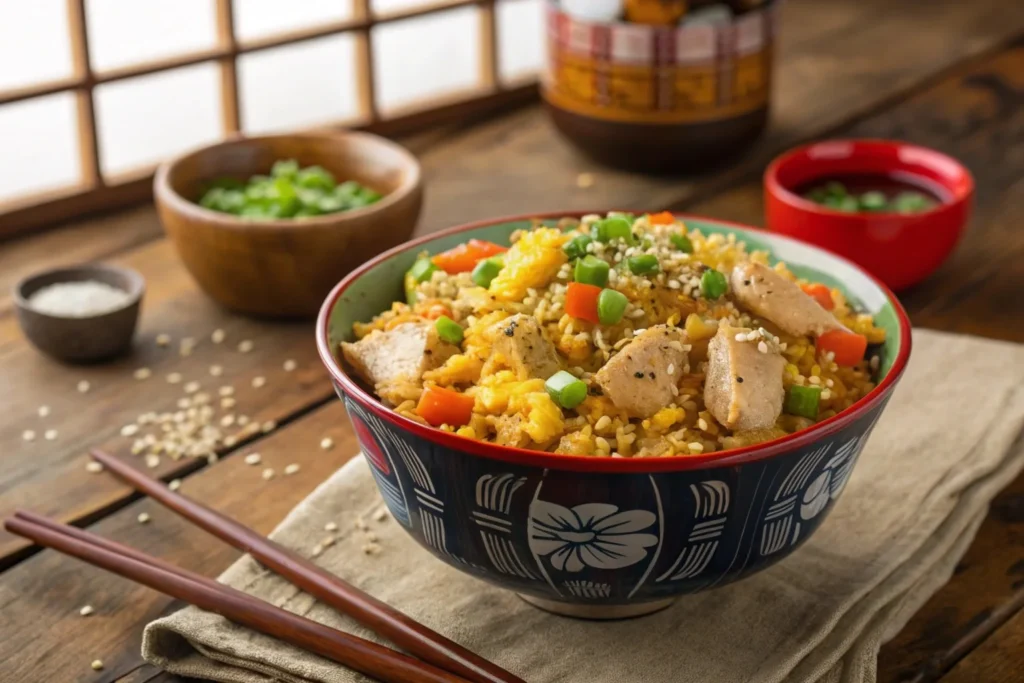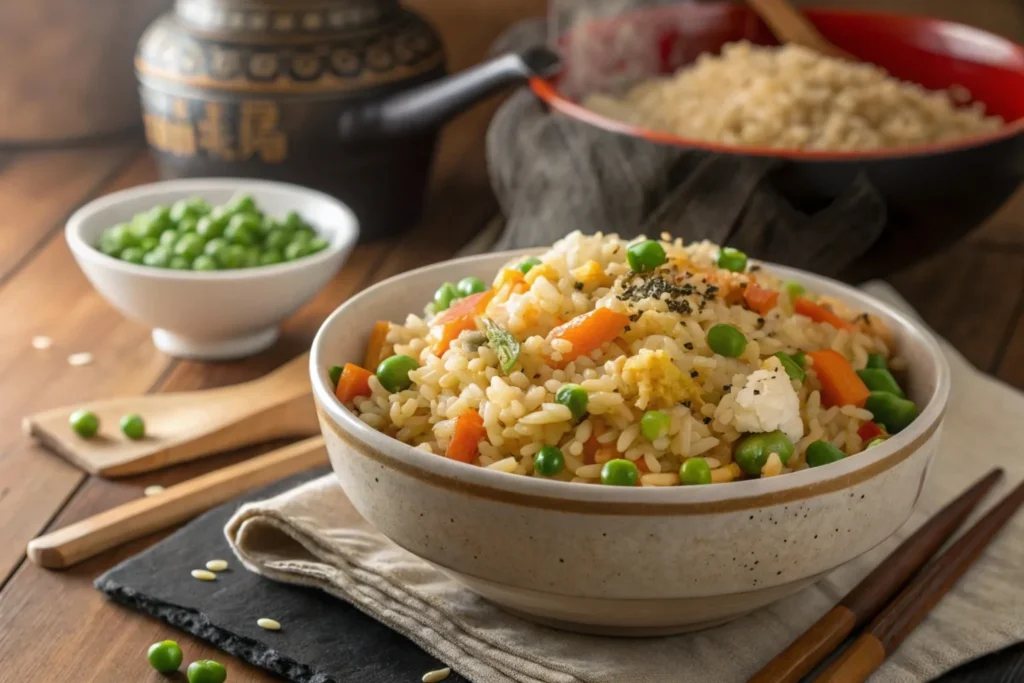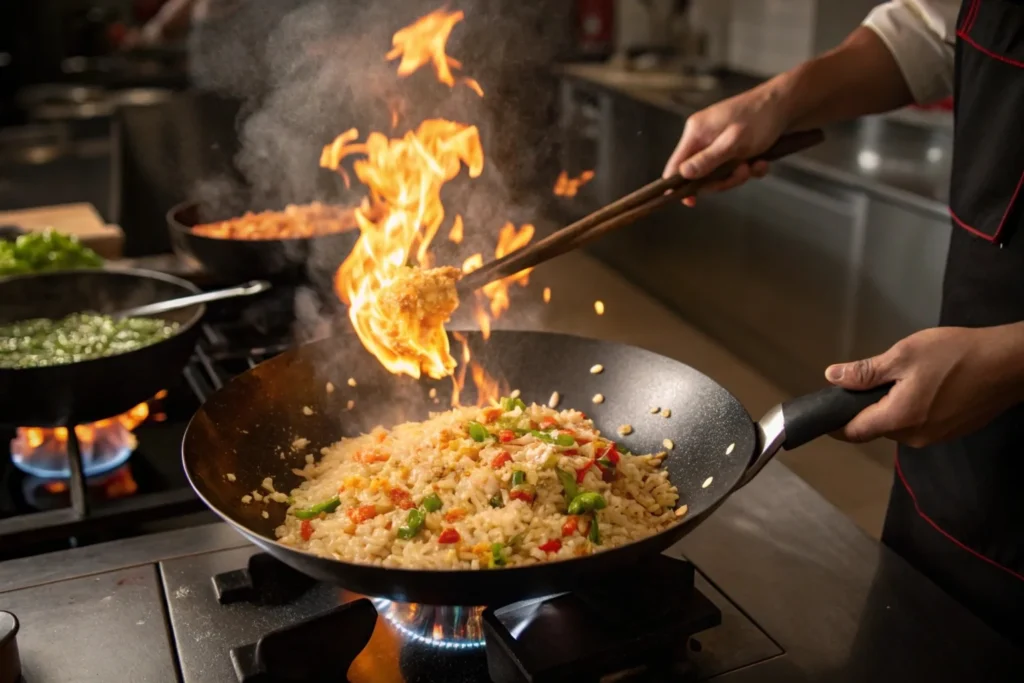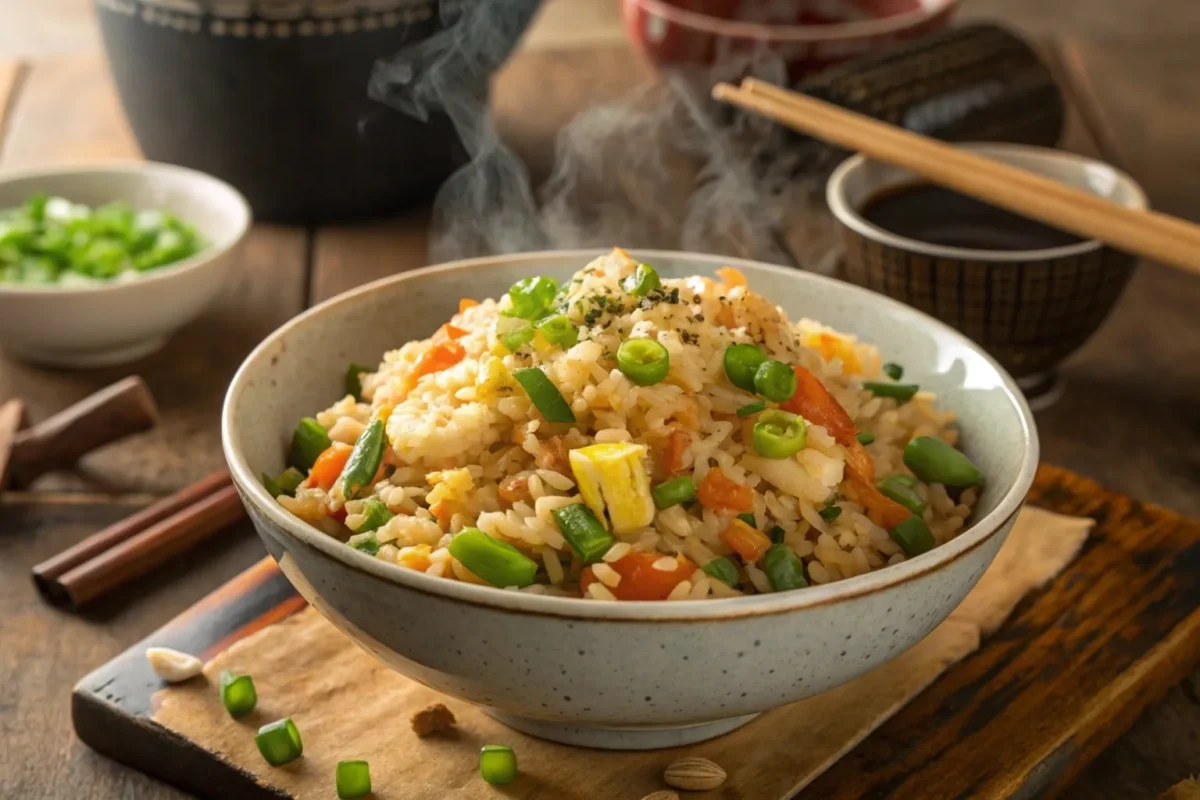Ever wondered why some homemade fried rice dishes become instant favorites? It might be because of the savory magic of Japanese fried rice recipe! This recipe is not just simple but also incredibly delicious and versatile. In this article, I’ll share everything you need to know, from the best ingredients to cooking tips. This way, your next meal will be a joy to make and eat.
Table of Contents
Introduction to Japanese Fried Rice Recipe
Exploring unique Japanese fried rice, I’m struck by its special traits. It stands out from other fried rice thanks to its tasty ingredients and cooking methods. These are deeply rooted in the history of fried rice.
What Makes Japanese Fried Rice Unique?
The secret to Japanese fried rice is its ingredients. Soy sauce brings a rich umami flavor, while dashi boosts the taste. The rice, made from short-grain varieties, is sticky and holds everything together well.
Vegetables, proteins, and sometimes nori add to the dish. This mix showcases traditional Japanese cuisine. Each bite is a burst of flavor.
A Brief History of Fried Rice in Japan
Fried rice’s journey to Japan started in China. Over time, it became a favorite among locals. It merged with Japan’s food culture, changing to fit local tastes.
Now, it’s a beloved dish, showing Japan’s diverse food scene. Learning about fried rice’s history is a tale of adaptation and taste that many can relate to.

Essential Ingredients for the Best Japanese Fried Rice
To make unforgettable Japanese fried rice, focus on key ingredients. The rice is the base of the flavor. Choose short-grain Japanese rice for the best results. It’s sticky, making each bite cling to the tasty additions.
Rice: The Foundation of Flavor
I always pick short-grain rice for this dish. It’s easy to fry and keeps moisture well. This rice is key for the authentic Japanese fried rice texture and flavor.
Choosing the Right Vegetables
For vegetables, I go for fresh ones like green onions, peas, and carrots. They add color and nutrients. Fresh veggies give a nice crunch against the soft rice. Try different seasonal veggies to make it your own.
Protein Options for Added Substance
Adding protein makes fried rice more filling. You can use chicken, shrimp, or tofu. I like mixing shrimp and tofu for a tasty seafood twist. It’s also good for vegetarians.
| Ingredient Type | Examples | Benefits |
|---|---|---|
| Rice | Short-grain Japanese rice | Sticky texture, enhances flavor |
| Vegetables | Green onions, peas, carrots | Add color, nutrition, and crunch |
| Protein | Chicken, shrimp, tofu | Increases substance and variety |
Japanese Fried Rice Recipe
Making my easy Japanese fried rice recipe is a fun cooking adventure. I share simple steps to help you make it at home. These steps ensure a perfect mix of flavors and textures.
Step-by-Step Instructions
Here’s how I make my fried rice:
- Start by cooking your rice. I use short-grain rice, which keeps its shape and soaks up flavors well. Rinse it under cold water until the water is clear to remove starch.
- For the best rice, use a 1:1.2 water-to-rice ratio. This adds a bit of extra water to avoid dryness.
- Let the cooked rice cool down before frying. This step prevents clumps and keeps the rice fluffy.
- In a hot pan or wok, heat oil and add diced veggies and proteins like chicken or shrimp. Stir-fry until they’re fully cooked.
- Add the cooled rice to the pan. Use a spatula to mix everything gently. This ensures even heat and flavor.
- Season with soy sauce, sesame oil, and a bit of salt and pepper. Stir well to mix all the flavors.
- Finally, toss in some green onions and serve hot.
For a detailed list of ingredients, visit Recipes Apart.
Tips for Perfectly Cooked Rice
Perfectly cooked rice makes a big difference. Here are my best tips:
- Rinse the rice before cooking for fluffiness.
- Use the right water-to-rice ratio for the best results.
- Let the cooked rice cool completely before frying. This step prevents clumps and blends flavors well.
Variations of Japanese Fried Rice Recipe
Exploring different Japanese fried rice variations meets various tastes and dietary needs. I find that trying new ingredients brings out unique flavors and textures. Two delightful variations are seafood fried rice and vegetarian fried rice.
Seafood Fried Rice
Seafood fried rice includes shrimp, squid, and other seafood. This mix not only boosts the flavor but also adds nutrition. Here’s how I make it:
- Start with cooked Japanese rice, preferably day-old for the best texture.
- Sauté a mix of chopped onions and garlic in oil until fragrant.
- Add the seafood and cook until just tender.
- Incorporate the rice, along with sesame oil, soy sauce, and vegetables like peas or bell peppers.
- Finish with a sprinkle of green onions for garnish.
Vegetable-Only Fried Rice
For a hearty vegetarian option, I suggest this flavorful fried rice. It uses a variety of vegetables, making it satisfying without animal proteins. Here’s my method:
- Use a colorful array of vegetables such as carrots, peas, broccoli, and bell peppers.
- Cook the vegetables until tender, maintaining their vibrant colors and crunch.
- Add the rice and season it with soy sauce and a hint of sesame oil.
- Include fried tofu for added protein and a wonderful texture.
These Japanese rice variations cater to different tastes and show fried rice’s versatility. Each option offers a unique twist while keeping the comforting essence of fried rice.
| Variation | Main Ingredients | Cooking Time |
|---|---|---|
| Seafood Fried Rice | Shrimp, squid, peas, onions, garlic | 15 minutes |
| Vegetarian Fried Rice | Carrots, peas, broccoli, bell peppers, tofu | 15 minutes |

Common Mistakes to Avoid
Making perfect Japanese fried rice needs some key techniques. Home cooks often make mistakes that can ruin the dish. Knowing these errors can improve your cooking and make your fried rice better.
Overcooking the Rice
One big mistake is overcooking the rice. This makes it mushy and hard to stir-fry. It’s important to use the right rice and cooking tips.
Use short-grain Japanese rice for the best results. Let the rice cool completely before frying. This helps each grain stay separate and adds texture.
Not Using Enough Seasoning
Another mistake is not adding enough seasoning. It’s easy to forget how much flavor soy sauce and other seasonings add. Start with a small amount and taste as you go.
Finding the right balance of flavors is key. A little experimentation with spices can make your fried rice unforgettable.
Tips for Meal Prep with Japanese Fried Rice Recipe
Meal prep can change how you cook, especially for easy weeknight meals. Japanese fried rice is great for meal prep because it’s versatile and can be made in big batches. Here are some tips on storing and using leftover fried rice.
How to Store Leftovers
Storing leftover fried rice right is key for safety and taste. Use airtight containers to keep it dry. Let the fried rice cool down before putting it in the container. Store it in the fridge for up to four days.
When you’re ready to eat it, reheat it in the microwave or on the stovetop. Add a bit of water to keep it moist. Here’s a quick guide:
| Storage Method | Duration | Reheating Tips |
|---|---|---|
| Airtight Containers | Up to 4 days in refrigerator | Add splash of water when reheating |
| Freezing | Up to 3 months | Thaw overnight in refrigerator before reheating |
Ideas for Quick Weeknight Dinners
After prepping a batch of meal prep fried rice, you can make many quick dinners. You can add new ingredients or flavors to make it your own. Here are a few ideas:
- Stir in leftover grilled chicken and vegetables for a complete meal.
- Add a fried egg on top for extra protein.
- Toss in some frozen peas and carrots for added nutrition.
- Mix in various sauces, like soy or teriyaki, for a flavor twist.
Pairing Suggestions
Choosing the right sides and drinks can make your Japanese fried rice meal even better. Here, I’ll share some great side dishes and drinks that go well with this tasty dish.
Best Side Dishes to Compliment Fried Rice
Here are some side dishes that can make your fried rice meal even better:
- Miso Soup – A warm bowl of miso soup adds a comforting touch and brings out the flavors of the rice.
- Gyoza – These crispy dumplings offer a savory contrast and work perfectly with fried rice.
- Pickled Vegetables – Providing a burst of acidity, pickled veggies balance the richness of the rice.
- Seaweed Salad – Packed with flavor and nutrients, this refreshing salad is a great sidekick.
Recommended Teas and Beverages
Here are some drinks that go well with your meal:
- Green Tea – A classic choice, it cleanses the palate while complementing the rice’s umami flavor.
- Sake – This traditional Japanese rice wine enhances the meal’s flavor profile, especially when cold.
- Japanese Beer – A crisp lager like Asahi or Sapporo can refresh and balance each bite.
- Ramune – This fun, fizzy drink adds a playful touch and pairs well with lighter flavors.
| Side Dish | Flavor Profile | Best Pairing |
|---|---|---|
| Miso Soup | Salty, Umami | Classic Fried Rice |
| Gyoza | Savory, Crispy | Chicken Fried Rice |
| Pickled Vegetables | Sweet, Tangy | Vegetable Fried Rice |
| Seaweed Salad | Salty, Fresh | Seafood Fried Rice |
With these tips, you’ll be a pro at pairing fried rice in no time!
Personalizing Your Recipe
Turning fried rice into something special is easy. I enjoy adding different spices and sauces to make it unique. A dash of sriracha adds heat, while sesame oil brings a deep flavor. These tweaks make your dish both tasty and memorable.
Experimenting with Spices and Sauces
Spices open up a world of flavors for your fried rice. Try garlic powder for more taste or ginger for a zesty touch. Each spice brings out a new side of the dish, making it fun to experiment.
Don’t be shy to add soy sauce or teriyaki for a rich umami taste. It’s all about finding what you love.
Adding Local Ingredients for a Fusion Twist
Using local ingredients is another great way to make your fried rice stand out. Maybe you have fresh herbs or veggies from your area. For example, adding corn or bell peppers can brighten up your dish with color and taste.
This approach not only makes your meal unique but also celebrates local flavors. It’s a way to show off your culinary style through your dishes.
Health Benefits of Homemade Fried Rice
Making Japanese fried rice at home is more than just a tasty treat. It’s a way to control what goes into your food. This means you can make sure your meal is healthy and meets your dietary needs.
Control Over Ingredients
One big plus of making fried rice yourself is the ability to pick the ingredients. You can choose fresh veggies, good proteins, and whole grains. This way, you avoid bad stuff like preservatives and unhealthy additives. It’s a great way to make a meal that fits your health goals.
Balanced Nutrition in Your Meal
Adding different veggies and proteins to your fried rice makes it balanced. A mix of greens, proteins like chicken or tofu, and whole rice makes it nutritious. Each bite is not just tasty but also packed with vitamins and minerals. Making your own meals is healthier, so you can enjoy great flavors without feeling guilty.
| Ingredient | Nutrition Benefits |
|---|---|
| Brown Rice | High in fiber, supports digestion |
| Spinach | Rich in iron and vitamins A, C, K |
| Chicken | Lean protein source, promotes muscle health |
| Carrots | Full of antioxidants, supports eye health |
| Eggs | High-quality protein, packed with nutrients |
Using fresh ingredients in Japanese fried rice makes it better for you. It’s not just about the taste. It’s about making choices that are good for your health and well-being.
Cooking Tips from My Kitchen
Making tasty fried rice needs the right tools and techniques. The right equipment makes cooking easier and improves the dish’s taste and texture. I’ll share my top kitchen tools for fried rice and favorite cooking methods for great results.
Essential Kitchen Equipment for Fried Rice
Here’s a list of my go-to kitchen tools for making perfect fried rice:
- Non-stick skillet: This is crucial for easy cooking and ensures that the rice does not stick together.
- Rice cooker: A reliable rice cooker guarantees perfectly cooked rice every time, which is the first step in achieving great fried rice.
- Sharp knives: Quality knives make chopping vegetables and proteins quick and efficient, ensuring even pieces that cook uniformly.
- Spatula: A sturdy spatula allows for efficient stir-frying and mixing of the ingredients.
My Favorite Cooking Techniques
Using the right cooking techniques can make your fried rice better. Here are some tips for making fried rice:
- Stir-frying: This method prevents sogginess while allowing the rice to absorb flavors from the other ingredients.
- High heat: Cooking on high heat helps achieve that coveted crispy texture on the rice.
- Brown the ingredients: Browning vegetables and proteins before adding the rice intensifies the flavors.
- Keep ingredients separate: Cooking protein and vegetables separately and combining them later enhances the overall taste and texture.
Using these tools and techniques will make your fried rice better. Feel free to try new things and find what you like best!

Conclusion
Japanese fried rice is not just tasty; it’s also a fun dish to make. The recipe lets you pick your favorite ingredients. This way, you can make it just how you like it.
By cooking at home, you can try different veggies, meats, and spices. This makes your dish truly special. I hope you’re excited to try making it yourself.
Japanese fried rice is great for any meal. It’s quick for weeknights or perfect for guests. So, open your pantry and get creative. The possibilities are endless!
FAQ
What type of rice is best for making Japanese fried rice?
Short-grain Japanese rice is the best choice. It’s stickier and tastier than long-grain rice. This makes your fried rice perfect.
Can I make Japanese fried rice vegetarian?
Absolutely! Use fresh veggies like bell peppers, peas, and carrots. Just skip the animal proteins.
How can I prevent the rice from becoming mushy when frying?
Cook the rice right, without overcooking. Let it cool before frying. This keeps it from getting mushy.
What proteins can I add to my fried rice?
You can add chicken, shrimp, tofu, or pork. Choose what you like and what fits your diet.
How do I store leftover fried rice?
Store it in airtight containers in the fridge. This keeps it fresh and flavorful.
What side dishes pair well with Japanese fried rice?
Try miso soup, gyoza, or pickled veggies. They make a great meal.
Are there any common mistakes to avoid when making fried rice?
Yes! Don’t forget to season it well. Use soy sauce and spices to avoid bland rice.
How can I make my fried rice healthier?
Make it at home with fresh veggies and lean proteins. This way, you avoid unhealthy additives.
What are some creative variations I can try with my fried rice?
Try new spices, sauces, or local ingredients. Add sriracha for spice or use seasonal veggies for a twist.
Can I use other types of sauces aside from soy sauce?
Yes! Try teriyaki, oyster sauce, or sesame oil. They add unique flavors to your fried rice.


1 thought on “Japanese Fried Rice Recipe”